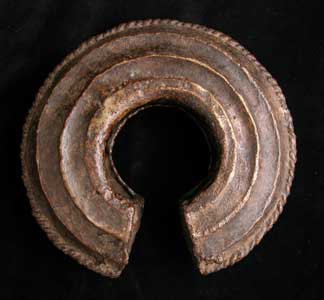Dida Bronze Money Bracelet, 19th Century CE
Bronze
7.75 x 2.125
PF.5898
Further images
Money is a medium of exchange; that is, any item used to facilitate commerce, beyond a simple bartering of goods. Mediums of exchange develop when any party wishing to obtain...
Money is a medium of exchange; that is, any item used to facilitate commerce, beyond a simple bartering of goods. Mediums of exchange develop when any party wishing to obtain a certain item has nothing needed by the owner to barter in return. It has taken many forms throughout history, including coins, tokens, paper currency, and those unusual items we call "primitive money.” Primitive moneys are items used in the same way that we use coins, but which do not have the mark of an issuing authority. They may or may not have an intrinsic value, but the culture that uses them accepts them even though the issuing authority may not be known. Most primitive moneys are culture-specific and did not circulate over wide areas. Generally they developed as precursor to the development of a true coinage. Africa has been the source of more types of primitive moneys than any other region of the world. Prior to the 19th century, true coins were used mainly in parts of north and northeast Africa, but the concept of money was well established throughout much of the continent. The use of primitive money was especially prolific in the area around the Congo basin and the Gold Coast regions. On the west coast of Africa, from the Congo, north to Senegal, bronze bracelets (properly called Manillas) were worn both for personal adornment and for use as money. Their use dates back to at least the late 16th century and possibly much earlier. It is often difficult to date Manillas, but it is reasonable to assume that most of the specimens we come across today were made in the late 18th and 19th centuries, although some date to the early part of this century. A few areas were still using them as late as 1948, and rumors persist that they are occasionally still used in a few remote villages in Burkina Faso.





